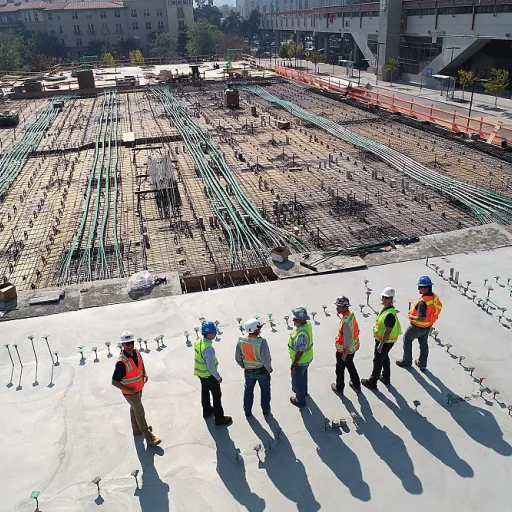
Understanding ageism and its impact on office culture
What is Ageism and Why Does it Matter in Emirati Offices?
Ageism refers to discrimination or unfair treatment based on a person's age. In the workplace, this can affect both older and younger employees, impacting job opportunities, performance evaluations, and even access to training opportunities. In the Arabian Emirates, where diversity and inclusion are increasingly prioritized, understanding ageism is crucial for office managers aiming to foster a positive work environment.
The Impact of Age Bias on Office Culture
When age bias goes unchecked, it can shape the entire office culture. Employees may feel undervalued or overlooked simply because of their age, whether they are older workers nearing retirement or younger employees just starting their careers. This can lead to decreased morale, lower performance, and even higher turnover rates. For example, mandatory retirement policies or assumptions about an employee's ability based on age can limit growth and innovation within the team.
- Older employees may be passed over for promotions or challenging projects.
- Younger workers might not be trusted with important responsibilities.
- Both groups can face stereotypes that affect their job satisfaction and performance.
Discrimination in employment based on age is not only unfair but can also violate employment law in many jurisdictions. Office managers should be aware of the signs of ageism and understand how it can affect the overall performance and well-being of their teams.
Recognizing the Need for Change
Addressing ageism in the workplace requires a proactive approach. By recognizing the signs of age-related bias and implementing an improvement plan, office managers can create a more inclusive environment. This means providing equal access to training, performance improvement plans, and advancement opportunities for all employees, regardless of age. For practical steps on efficiently monitoring processes and ensuring fair treatment, consider exploring efficiently monitoring the design process with ticketing systems as a way to promote transparency and accountability in your office.
Common examples of ageism in the workplace
Everyday Scenarios Where Age Bias Emerges
Ageism in the workplace can take many forms, some obvious and others more subtle. Office managers in the Arabian Emirates may encounter situations where employees are treated differently based on their age, affecting both older and younger workers. Recognizing these examples is the first step toward building a fair and inclusive environment.
- Limited Training Opportunities: Older employees may be overlooked for training or professional development, with the assumption that they are close to retirement or less adaptable to new technology. This can hinder their performance improvement and career growth.
- Promotion and Job Opportunities: Sometimes, younger employees are favored for promotions or challenging assignments, while older workers are passed over despite their experience. This age discrimination can impact morale and lead to feelings of exclusion.
- Mandatory Retirement Policies: While employment law in the UAE sets guidelines for retirement, enforcing mandatory retirement without considering individual performance or willingness to work can be a form of discrimination employment based on age.
- Negative Stereotypes: Comments or jokes about someone being "too old" or "too young" for a job can reinforce age bias. These attitudes may influence decisions about hiring, firing, or assigning tasks.
- Performance Improvement Plans: Older workers might be placed on performance improvement plans more frequently than younger colleagues, sometimes based on assumptions rather than actual job performance.
- Exclusion from Projects: Both older and younger employees may be excluded from key projects or meetings, with the belief that their age makes them less suitable or less likely to contribute valuable insights.
These examples ageism are not just theoretical. They reflect real challenges faced by employees in Emirati offices. Addressing such discrimination workplace issues requires awareness and proactive management.
For practical tips on fostering better communication and inclusion during meetings, you can read about how to effectively conclude meetings in an Arabian Emirate company.
Understanding these scenarios helps office managers identify workplace ageism and take steps to ensure equal opportunities for all employees, regardless of age. This is essential for compliance with employment law and for promoting diversity inclusion in the workplace.
Subtle signs of age-related bias in Emirati offices
Recognizing subtle age-related bias in Emirati offices
In the Arabian Emirates, office managers often focus on visible forms of discrimination, but ageism can appear in less obvious ways. Understanding these subtle signs is essential for promoting diversity and inclusion in the workplace. Here are some real-life examples and patterns that may indicate age-related bias:
- Assumptions about technology skills: Older employees may be overlooked for digital projects or training opportunities, based on the belief that younger workers are more tech-savvy. This bias can limit job opportunities and hinder performance improvement for experienced staff.
- Unequal distribution of challenging tasks: Managers might assign high-profile or innovative work to younger employees, assuming older workers prefer routine tasks. This can affect employee morale and create a sense of exclusion.
- Comments about retirement or age: Even casual remarks about "slowing down" or "when are you retiring?" can signal age bias. Such comments, though sometimes unintentional, contribute to a culture of age discrimination in the workplace.
- Limited access to training and development: If older workers are not encouraged to join training sessions or improvement plans, it may reflect an assumption that investment in their development is less valuable. This impacts both performance and long-term employment opportunities.
- Promotion and advancement barriers: Age bias can manifest when older employees are passed over for promotions in favor of younger colleagues, regardless of performance or experience. This is a clear example of age discrimination employment practices.
Recognizing these subtle signs is the first step for office managers to address ageism workplace issues. It is important to regularly review employment law updates and company policies to ensure fair treatment for all employees, regardless of age. For those managing secure digital access for diverse teams, streamlining SecureLink login for office managers can help ensure equal access to resources for both older and younger workers.
By staying alert to these subtle signs age bias, managers can create a more inclusive environment, where every employee—regardless of age—feels valued and empowered to contribute to the success of the organization.
How ageism affects productivity and team morale
Impact on Team Dynamics and Performance
Ageism in the workplace can quietly undermine both productivity and morale among employees. When workers—whether older or younger—feel they are being treated differently based on age, it can lead to disengagement, lower job satisfaction, and even higher turnover rates. For example, if older employees are overlooked for training opportunities or challenging projects, they may feel undervalued and less motivated to contribute. Similarly, younger employees who are not trusted with responsibilities may become frustrated and less likely to share innovative ideas.
Consequences for Productivity and Collaboration
- Reduced collaboration: Age bias can create divisions within teams, making it harder for people of different ages to work together effectively. This can slow down project completion and reduce overall team performance.
- Missed opportunities: When managers make assumptions about what employees can do based on age, they may miss out on valuable skills and perspectives. For example, older workers may have deep industry knowledge, while younger workers may bring fresh approaches.
- Negative impact on performance improvement: If performance improvement plans are applied inconsistently—such as only targeting older workers—this can be seen as discrimination and may even violate employment law in the Arabian Emirates.
Legal and Reputational Risks
Discrimination based on age, including mandatory retirement or denying job opportunities, can expose companies to legal challenges under local employment law. Beyond legal risks, workplace ageism can damage a company’s reputation, making it harder to attract and retain top talent. Employees who experience or witness age discrimination may share their experiences, affecting the company’s image as a diverse and inclusive employer.
Creating a Culture of Continuous Improvement
Addressing ageism workplace issues is not just about compliance. It’s about building a culture where all employees—regardless of age—feel respected and empowered to contribute. This includes offering equal access to training, fair performance evaluations, and opportunities for advancement. By recognizing the signs of age bias and taking action, office managers can foster a more positive and productive work environment for everyone.
Best practices for office managers to prevent ageism
Practical steps to reduce age-related discrimination
Office managers in the Arabian Emirates play a crucial role in preventing ageism and promoting a fair workplace. Addressing age discrimination is not just about compliance with employment law, but also about creating an environment where both older and younger employees can thrive. Here are some actionable strategies:- Review recruitment and promotion processes: Ensure job postings and hiring criteria do not favor a specific age group. Avoid language that suggests a preference for "young and energetic" or "digital native," as this can discourage older workers from applying.
- Offer equal training opportunities: Make training and development programs accessible to all employees, regardless of age. This helps both older employees and younger workers improve their skills and performance, and demonstrates a commitment to diversity inclusion.
- Implement a clear anti-discrimination policy: Establish and communicate a policy that explicitly prohibits age bias and age-related discrimination in the workplace. Ensure all employees are aware of the consequences of violating this policy.
- Monitor for subtle signs of ageism: Regularly assess the work environment for examples of ageism, such as exclusion from projects or assumptions about technology skills based on age. Encourage employees to report concerns without fear of retaliation.
- Provide performance improvement plans fairly: When addressing performance issues, ensure that improvement plans are based on objective criteria and not influenced by age bias. This helps prevent discrimination workplace scenarios where older workers are unfairly targeted.
- Encourage intergenerational collaboration: Create opportunities for employees of different ages to work together on projects. This can break down stereotypes and foster mutual respect.
- Stay informed about employment law: Keep up to date with local regulations regarding age discrimination, mandatory retirement, and equal employment opportunities. This ensures compliance and protects both the company and its employees.
Supporting ongoing improvement and accountability
Building a workplace free from ageism requires continuous effort. Office managers should:- Regularly review policies and practices for signs age bias may be present.
- Collect feedback from employees about their experiences with ageism workplace issues.
- Use real-life examples ageism to educate staff and promote awareness.
- Set measurable goals for diversity inclusion and track progress over time.
Building a culture of respect for all ages in the Arabian Emirates
Encouraging Open Dialogue and Feedback
Building a culture of respect for all ages in the workplace starts with open communication. Office managers should encourage employees—both older and younger—to share their experiences and concerns about age bias. Regular feedback sessions can help identify subtle signs of ageism and provide real-life examples of discrimination that may otherwise go unnoticed. This approach not only helps address age discrimination but also fosters trust among workers of all ages.
Implementing Fair Employment Practices
To prevent age-related discrimination, it is essential to ensure that all employment practices are fair and transparent. This includes recruitment, job assignments, training opportunities, and performance improvement plans. Avoid making decisions based on age or assumptions about older or younger employees’ abilities. Instead, focus on skills, experience, and performance. For example, avoid mandatory retirement policies unless required by law, and ensure that all workers have equal access to opportunities for advancement.
Promoting Diversity and Inclusion Initiatives
Office managers can play a key role in promoting diversity and inclusion by organizing workshops and training sessions that highlight the value of a multigenerational workforce. These initiatives should cover the impact of ageism in the workplace and provide practical examples of how age bias can affect employee morale and job performance. By raising awareness, managers help employees recognize and challenge their own biases, leading to a more inclusive environment.
Recognizing and Rewarding Contributions
It is important to recognize the achievements of employees regardless of age. Celebrate both older workers’ experience and younger employees’ fresh perspectives. Public acknowledgment and fair reward systems can help reduce age discrimination and promote a sense of belonging. This approach also demonstrates that performance and contribution, not age, are the basis for advancement and recognition in the company.
- Encourage mentorship programs between older and younger workers
- Review employment policies regularly to ensure compliance with employment law
- Provide ongoing training opportunities for all employees
- Monitor for signs of age bias in performance reviews and job assignments
By taking these steps, office managers in the Arabian Emirates can create a workplace where every employee, regardless of age, feels valued and respected. This not only helps prevent discrimination workplace issues but also supports better performance and job satisfaction for all.













